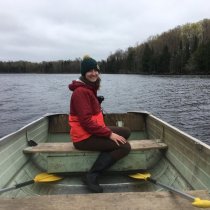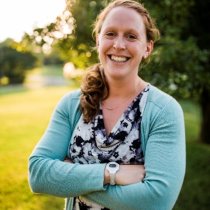Spotlight
Women in Ecology – Cayelan Carey
April 1, 2020
In our conversations with female ecologists, we’ve heard themes about how to not only recruit women into STEM fields but also how to retain women in professional roles within scientific and academic institutions. The value of mentors for female students and early-career scientists cannot be overstated, for example.
We’ve also found that large-scale research networks can provide a valuable means of support for female scientists, young students and other traditionally under-represented groups within scientific fields. By crossing over disciplines and institutions, research networks such as NEON and many others can offer scientists novel partnerships, new experiences and a supportive group of diverse colleagues.
We recently discussed this with Dr. Cayelan Carey, Associate Professor of Biological Sciences at Virginia Tech, who specializes in freshwater ecology and ecosystem ecology. Dr. Carey shared how her experiences with important mentors and various research networks played a key role in her educational and professional development.
Q: What inspired you to become involved in your current research/field?
A: I grew up in upstate New York spending a lot of time outdoors in the Adirondack Mountains with my family. This was at the height of the acid rain crisis: seeing the lake ecosystems I loved rapidly change during my childhood is what motivated me to become a freshwater ecosystem ecologist.
Q: Please tell us a little about your career path.
A: I realized very early that I wanted to be a freshwater ecologist, and had a seminal experience working with Kathy Cottingham and Kathleen Weathers studying phytoplankton in New Hampshire lakes as an undergraduate at Dartmouth College. I received a Fulbright scholarship to study phytoplankton blooms in Sweden, where I became interested in phosphorus cycling and interactions between nutrient cycling and water quality. After my Fulbright I returned to the U.S. and got my PhD at Cornell University, where I worked on low-nutrient lakes in New England that had recently started exhibiting phytoplankton blooms. These lakes had historically been categorized as “pristine,” so I was interested in studying why they were occurring as well as their effects on the resilience of these lakes.
I was then at University of Wisconsin-Madison for a year as a post-doc, working with Dr. Paul Hanson. I had a strong empirical skill set coming out of my PhD but I wanted to understand ecology more mechanistically, so I worked with Paul to learn different ecosystem modeling techniques. This skill set was really important to my development as an ecologist—understanding how lakes work in modeling space has enabled me to better understand how these ecosystems function as well as where we have gaps in our empirical knowledge. I arrived at Virginia Tech in 2013 and have been doing field work and data-intensive modeling approaches exploring both how human activities affect freshwater ecosystems and in turn how changing water quality modifies human decision-making.
Q: Who were your most important influences/mentors in ecological science?
A: My dad was a scientist who actively encouraged me to pursue my love for lakes growing up. The professors we just discussed were—and still are—extremely supportive. In addition to those individuals, the Global Lake Ecological Observatory Network (GLEON) was a really important part of my training and career. It’s a grassroots science network of approximately 800 researchers around the world who share data collected from sensors on buoys, and it has a strong emphasis on collaborative science and how to practice interdisciplinary science. This group has been a touchpoint for me as a grad student, then as a post-doc, and now as a faculty member I serve on its steering committee and get to see my students “grow up” in this network.
Q: What challenges do you think women may face getting into STEM fields? Have you experienced or overcome any of these?
A: First of all, it’s really important to have female mentors and role models. I’ve had two fabulous women mentors in science whose footsteps I follow. Beyond that, one thing we don’t often talk about is not just recruiting women but retaining them—there are systemic issues with how academia works that affect retention of female scientists that must be addressed across universities. Moreover, it’s important to emphasize that you can be a great scientist and also a great mom and great partner and great daughter, as well as many other roles. There’s a perception that being a scientist requires 100 percent devotion and that it comes at the expense of every other part of your life. Seeing my mentors as caregivers—both to their parents and kids—and seeing them play many other roles in their communities has shown me how I can carve out that balanced life for myself.
I focus on being open about how I have a toddler son (who had a cameo role in the NEON Open Data video!) and a life outside of the lab, and how this doesn’t hold me back but instead makes me a better scientist because I think about things in ways I wouldn’t otherwise. For example, my son will grow up in a world with different climate and water quality conditions than those that I grew up with. Thinking about future conditions in this way motivates the ecological forecasting component of my research, as well as the importance of doing basic ecology that has a strong applied component to help water management in the community where I live.
Q: How can research and educational institutions inspire more women to study fields in ecology and then remain on this professional track?
A: We need to embed quantitative skills throughout ecological training, specifically at the undergraduate stage, rather than waiting until grad school, to give students the chance to work with big data, modeling, and related technologies. There can be a lot of fear and anxiety around math, so integrating math and ecology early for female students with hands-on activities in undergraduate classrooms can hopefully help to keep them engaged longterm. I lead an educational program called Macrosystems EDDIE to embed NEON data in study materials, so I feel very passionate about this topic!
Also, having as much support as possible early in a female scientist’s career is vital. We have to realize that a career has many chapters. In the early stages of a woman’s career, you’re working on getting tenure, you’re trying to get research off the ground, you’re starting a family—everyone needs a support system to manage all of this. Then in the mid-career stage, we need to make sure leadership and scientific opportunities are available beyond the first promotion. I know multiple women reaching that second phase who feel like their career has stalled out. How can we as a scientific community help each other to be successful, however you define success? Whatever those answers are, the opportunities for continued growth need to be available.
Q: What work are you most proud of at this point in your career?
A: What a fun question to reflect on! I would have to highlight two projects: first, I predominantly studied glacially formed lakes before coming to Virginia Tech, and after I started here I expanded my research program to focus on human-created reservoirs. Learning a whole new focal research ecosystem has come with a steep learning curve but has been remarkable in terms of allowing me to pursue lots of new and exciting questions. Reservoirs are beautiful ecosystems and extremely important for society yet surprisingly under-studied despite their importance for society and fascinating biogeochemistry.
Secondly, I’m the Principal Investigator (PI) on an interdisciplinary team of researchers building water quality forecasting systems. We’re creating something similar to a weather forecast but for water quality. For example, imagine being able to predict “there is a 50 percent chance of an algal bloom occurring” on a given day for a particular lake. This can inform managers about how to treat drinking water in anticipation of future water quality impairment. Through the Ecological Forecasting Initiative, GLEON, and other research networks we’re aiming to up-scale this to lakes and reservoirs around the world. We’re not just trying to explain ecological phenomena, but to predict future dynamics—it’s very exciting.
Q: What do you hope to do in your field in the future?
A: I’m excited to scale our ecological forecasts to other lakes and reservoirs. Large-scale research networks like GLEON, NEON, and the Ecological Forecasting Initiative are sitting at the intersection of many different disciplines across ecology and are ripe for bringing together researchers to tackle complex global-scale environmental challenges.
Q: What is the most satisfying part of being an ecologist? What is the most challenging?
A: The most satisfying aspect of ecology is working at the intersection of different disciplines: fundamentally, I have become a better freshwater ecologist by having to explain my work to colleagues in computer science, social science, engineering, geochemistry, and economics. I also love being a mentor to my students because at the end of the day science is all about people. It’s extremely rewarding to help my students reach their potential and it’s the best part of my job.
The most challenging part, but something that I value about ecology, is being able to work on both basic and applied research at the same time. For example, my work on reservoirs tackles both fundamental ecosystem ecology while simultaneously tries to help managers and people who are reliant on these waterbodies for drinking water.
Q: Tell us more about your work studying how natural and anthropogenic perturbations affect freshwater systems.
A: The overarching theme of my lab is studying how land-use change and climate change are modifying lakes and reservoirs, and how those changes are in turn affecting human decision-making. For example, I’m co-PI on a study that focuses on building models of the impact of changing land use on water quality, and how that water quality will alter watershed and waterfront property values. We’ve already found a decline in property values around Lake Mendota in Wisconsin associated to water quality degradation. Another instance is how altered water quality changes people’s behavior in joining lake associations—if you’re seeing changing water quality it may motivate you to engage in your community in a way that it didn’t before.
Q: What is the most alarming discovery you have made? What is the most promising?
A: The most alarming is seeing climate change over the course of my career, which has not been that long in an ecological sense. The focal reservoir that I work on did not freeze this winter, despite that its historical record shows it freezing up to several months each winter. It’s concerning to think of what the effect on water quality will be this summer.
In terms of the most promising, I would say it’s seeing these large research networks coming together to provide an important platform enabling collaboration. Networks such as NEON and GLEON are supporting scientists working across disciplines and across institutions, and this type of interdisciplinary work may not happen without these networks. Finally, I also think it’s really important to have frank discussions about women in science and how networks can support them. In my experience, working with NEON and GLEON is really rewarding and has been important across my entire career.

Dr. Cayelan Carey, Associate Professor of Biological Sciences at Virginia Tech, in the field



